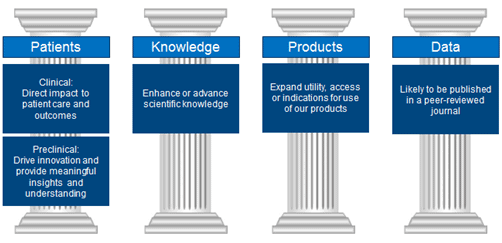Investigator-Sponsored Research Program
ASK A QUESTION
Research areas
Each Boston Scientific division reviews research requests for a variety of topics pertaining to Boston Scientific products and associated disease states.
We are currently looking for research in the following areas:
Interventional Cardiology/Structural Heart Topics of Interest
TAVR: Acurate™ Aortic Valve System
- Efficacy in complex cases, unique aortic anatomies and subpopulations
- Embolic protection
- Health economics analysis
WATCHMAN™ Appendage Closure Device
- Imaging
- Health economics data
- Blood thinner comparative data
- Subgroup analysis
Complex PCI
- FFR, iFR, DFR usage
- Health economics and efficiency analysis
Stents and Balloons
- Agent and Synergy applications and sub-population data
Rhythm & Electrophysiology Topics of Interest
ELECTROPHYSIOLOGY: Cardiac Mapping and Ablation
Personalization of Ablation Strategy
- Atrial fibrillation strategy personalization when considering multiple technology options
Ultrahigh Density Mapping and RF Ablation Catheters
- Characterization and prospective evaluation of local impedance-guided AF ablation using DIRECTSENSE™ (INTELLANAV MIFI™ OI & STABLEPOINT™ Catheters)
- DIRECTSENSE workflow and substrate characterization in complex cases
- High-power short-duration ablation workflow for pulmonary vein isolation
- Procedural best practices and outcomes with state-of-the-art technology, including RHTYTHMIA HDx™ with ultra-high-definition mapping and/or DIRECTSENSE, AutoTag, and LUMIPOINT™ features
- Substrate mapping and scar voltage characterization using RHYTHMIA HDx
PVI with Cryoablation Technologies
- Optimal dosing strategy for cryoablation using the POLARx™ cryoballoon
- Procedural best practices, efficiencies, and long-term clinical outcomes
RHYTHM MANAGEMENT Devices
Heart Failure Diagnostics on CIED Devices
- Intersection of HeartLogic™ and arrhythmic events and monitoring (e.g., arrhythmia burden, intervention decision & monitoring of response)
- Data management and workflow strategies utilizing HeartLogic alerts
- Treatment protocols for the whole alert cycle and relation to clinical outcomes
Implantable Cardiac Monitor
- Comparison of data management and clinic burden between LUX-Dx™ and other monitoring systems
- Use and performance of novel features including AT algorithm or remote programming
- User experience including implant and signal quality
- Patient experience and usefulness of mobile applications
Subcutaneous ICD
- Best practices to assure long-term device efficacy for spontaneous arrhythmias, particularly at device changeout
Endoscopy Areas of Interest
- SpyGlassTM Discover Digital Catheter (Surgical or Percutaneous)
- Cholangioscopy and Bil RFA in Occluded Bil SEMS
- Biliary RFA focused on improving life expectancy and reducing re-intervention rates
- Hybrid ESD or Hybrid EMR as a step to ESD using ORISETM ProKnife
- Single-use duodenoscopes
- Single-use bronchoscopes
- Clipping for:
- Anchoring of J-tubes
- Marking
- Closure
- Specific areas of interest in these topics include but are not limited to the following:
- Economic Data (Reduced procedural time, decreased length of hospital stay, reduced complications, lower hospital)
- Safety and efficacy
Urology Topics of Interest
Urolithiasis
- Treatment outcomes in upper tract urinary stone disease
Benign Prostatic Hyperplasia (BPH)
Rezūm™ Water Vapor Therapy (Rezūm)
- Patient Experience
- Optimizing patient experience without compromising efficacy
- Effectiveness
- Treatment durability
- Volume reduction
- PSA reduction/control
- Sexual Function Preservation
- Disease Progression
- Comparative impact on BPH disease progression (compared to medications, MITs, and invasive surgical options)
- Health Economic & Cost-savings
- Economic impact compared to other BPH treatments
GreenLight XPSTM Laser Therapy System (GreenLight)
- Patient experience compared to other BPH treatment types
- Safety, recovery, and durability of outcomes
- Day case procedures and increased OR efficiency
- Treatment techniques
- Impact of technique on patient outcomes
- Optimization of treatment plans
- Patient Selection
- Relevant comorbidities and increased risk of bleeding
- Core considerations for PVP as primary treatment (patient phenotype)
- PVP as a secondary treatment (following prior treatment failures)
Oncology Hydrogels – Prostate Cancer
- SpaceOAR™ and SpaceOAR Vue™ Hydrogels for GU Toxicity, GI & GU QOL
- Spacing in moderate and extreme hypofractionation, dose escalation and lesion boost
- Impact of CT visibility on contouring, planning, visualization and adaptive therapy
- Spacing in high-risk patients and extracapsular extension (non-posterior)
- Comparative studies on SpaceOAR Vue advantages relative to other rectal spacers
Female Stress Urinary Incontinence
- The case for minislings as standard of care therapy for stress urinary incontinence
- Patient experience
- Economics
- A systematic review and meta-analysis of the safety and efficacy of urinary slings for treating female stress urinary incontinence
- Incidence of complications following sling surgery in high risk women (obesity, medical comorbidities, concomitant hysterectomy etc.)
- Learning curve for Solyx™ Single-Incision Sling System
Pelvic Floor Reconstruction
- Use of Capio™ SLIM Suture Capturing Device in native tissue repair for prolapse
- Safety and efficacy of Y- mesh implanted by transabdominal route
Male Stress Urinary Incontinence
- AMS 800™ Artificial Urinary Sphincter (AUS) / AdVance™ XP Male Sling System (AdVance XP) vs comparative device studies or succession of prior procedures
- Patient and/or Caregiver satisfaction and experience
- Performance & treatment outcomes
- AUS / AdVance XP outcomes on sub-patient populations
- Obese, elderly, trauma, neurogenic (i.e. spina bifida)
- Post BPH procedures: TURP, brachytherapy, etc.
- Sub-sequent radiation treatment post-device implant
- Atrophy & Erosion studies
- Female AUS studies
- Causes for revision, outcomes, best practices
- Outcomes in conjunction with prolapse repair
- Patient selection: sling/mesh vs AUS
- Continence and ED
- Impact of AUS / AdVance XP on sexual function/satisfaction
- Outcomes with AdVance XP or AUS and Inflatable Penile Prothesis (IPP) combination
- Economics of Incontinence
- Coping costs (i.e. pads/laundry/pills)
- Economic impact on society
- Patient productivity
- Mental health
- Benefit of diagnosing Incontinence
- Cardiovascular
- Diabetes
- Obesity
Male Erectile Dysfunction (ED)
- Corporal measurements, measurement technique, and resulting cylinder size
- Cylinder sizing methodology/technique
- Satisfaction associated with specific cylinder sizes
- Same sex partner and patient satisfaction
- Safety and performance (erectile function satisfaction) outcomes associated with anal penetration utilizing a penile prosthesis
- Tactra™ Malleable Penile Prosthesis (Tactra) / Spectra™ Concealable Penile Prosthesis (Spectra) AMS 700™ Inflatable Penile Prosthesis (AMS 700)
- AMS 700, post-Tactra/Spectra – satisfaction, complications
- Reservoir fill volumes and satisfaction
- Reservoir model, fill volumes and cylinder size.
- Penile prosthesis, post-Rezūm therapy
- Repetitive high impact activities (biking, horseback riding and scuba diving), post-penile prosthesis: outcomes.
Neuromodulation Topics of Interest
- Spinal Cord Stimulation
- Treatment of chronic, intractable pain of the back and legs using the Spectra WaveWriter™ SCS System
- Of particular interest:
- Efficacy of combination therapy
- Programming optimization
- Contour™ field shaping algorithm vs other field shapes
- Anatomical vs paresthesia-based neural targeting
- Of particular interest:
- Treatment of chronic, intractable pain of the back and legs using the Spectra WaveWriter™ SCS System
- Deep Brain Stimulation
- Treatment of Parkinson’s Disease and other movement disorders using Vercise™ Deep Brain Stimulation System
- Of particular interest:
- Freezing of gait
- Replacement of other DBS systems with Vercise DBS System
- Use of multiple frequencies on one lead
- Use of current fractionalization to maximize overlap with desired structures and minimize stimulation of non-target tissue
- Novel targets for Parkinson’s Disease, Dystonia, Tremor (may require IDE)
- Of particular interest:
- Treatment of Parkinson’s Disease and other movement disorders using Vercise™ Deep Brain Stimulation System
How the U.S. Physician Payment Sunshine Act Impacts Sponsored Researchers
The U.S. Physician Payment Sunshine Act requires all pharmaceutical, biologic, and medical device manufacturers – like Boston Scientific – to report annually to the U.S. government payments and transfers of value made to U.S. physicians and teaching hospitals. This will include educational and research grants and charitable donations.
Read additional details about the U.S. Physician Payment Sunshine Act

